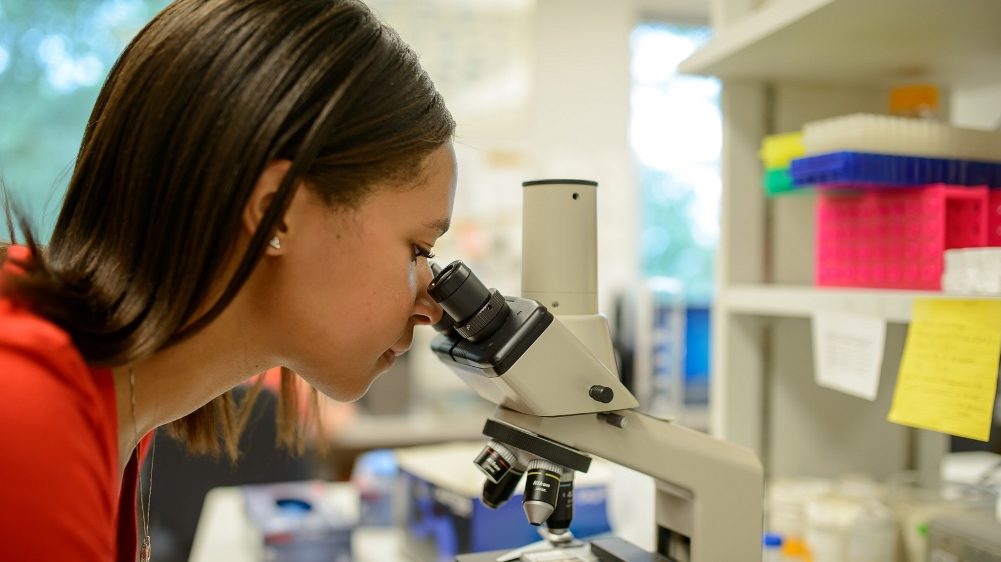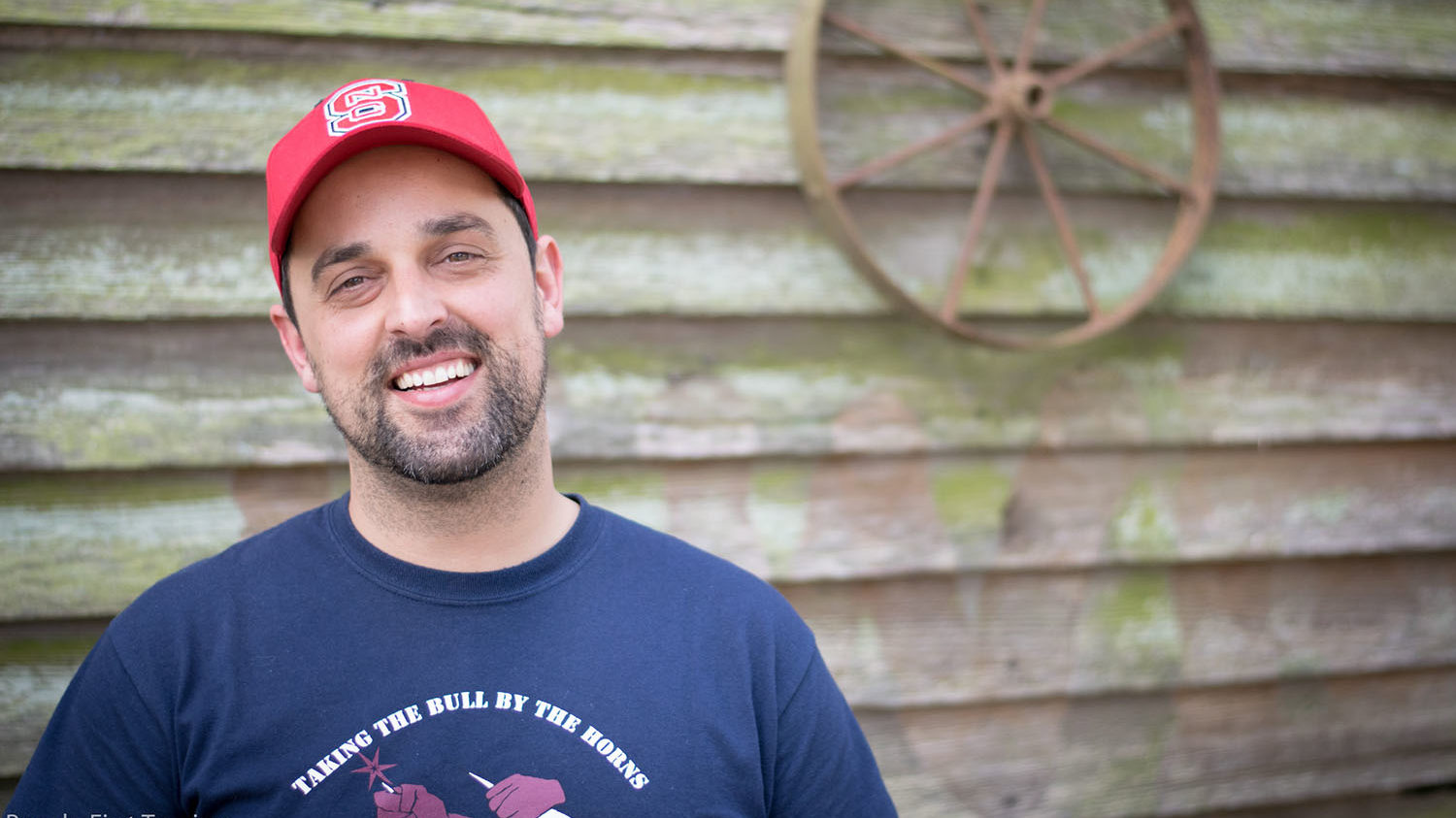Charisse Holmes

A Toxicologist with a Scientific Purpose and a Humanistic Focus
Toxicologist Charisse Holmes has been interested in health and science since her undergraduate days studying chemistry. At NC State, she investigated adverse health triggers which can occur in ubiquitous consumer products. This summer, she launched her toxicology career, working in drug safety with PRA Health Sciences in Charlottesville, Va.
“I think in general, society is getting a little better about being informed and staying on top of what we are exposed to,” Holmes says, using the example of a simple water bottle on the table before her. “Now, you see things on water bottles about BPA. Even though I’m 28, I knew there wasn’t as much stressed about that in the past.”
Water bottles were only one indication of an increasing level of public engagement and interest in consumer safety. Bisphenol A, commonly known as BPA, has been used since the 1950s in many household products, including baby bottles. Known to be an endocrine disrupter, BPA is now banned from certain products.
As a toxicologist, Holmes doesn’t duck the big issues facing health and science, such as cancer-causing compounds.
In fact, she continues doing what she has since a teenager with a gift for science: she dove in head-first, immersing
herself in her work, while also investing herself in her community.

EARLY DAYS AS A RESEARCHER
Holmes first became interested in cancer research as a Wake Forest University undergraduate.
“I performed experiments for advisor Mark Welker, chemically synthesizing a uniquely designed prostate cancer-specific PL 3-kinase inhibitor.” Prostate cancers rely upon signaling for their survival and growth. The family of enzymes the inhibitor belonged to perform various cellular functions, some of which were involved in cancers.
After completing her undergraduate degree, Holmes transitioned for a year to a breast cancer project at Wake Forest Medical Center. “We predicted that muscadine grape seeds and muscadine grape skin extracts could inhibit breast cancer. We tested this hypothesis using breast cancer cells and nude mice. I also worked with Mark Espeland on a clinical trial project called LOOK AHEAD and analyzed data using SAS software.” Muscadine grapes are a known source of polyphenols, with healthy benefits.
Fast forward only a few years. Holmes, a Delaware native, remained in North Carolina and applied to Graduate School at NC State. She had her sights on earning a doctorate in biological science. She obtained her doctorate in May this year.
Holmes worked under research professor Gerald A. LeBlanc, director of the toxicology program at NC State. She remains fascinated by helping further the ways in which better science can make us healthier. “After acquiring those research experiences, I picked Jerry LeBlanc’s lab because I thought he was a great guy and his lab seemed like it would be a great fit for me. He was interested in chemical mixtures, nuclear receptor signaling pathways pertaining to human health, and metabolic disorders such as weight gain and diabetes,” she explains. “Basically, it’s a blend of my interests and topics that I had worked on in the past.”
LeBlanc’s research work in metabolic syndrome is a familiar media topic. It is a serious medical condition frequently discussed on health care websites and in physicians’ offices. According to LeBlanc, the condition is now endemic in the U.S.
“A lot of people define metabolic differently,” says Holmes. “Typically, it involves weight gain, cardiovascular disease and type 2 diabetes.”
METABOLIC SYNDROME—A GROWING PROBLEM WITH ENDEMIC NUMBERS
Metabolic syndrome is a prevalent medical condition earmarked by the presence of several indicators (e.g., high blood sugar levels, excess abdominal fat, and/or high blood pressure) that become far more serious when they occur together. As a cluster of conditions, metabolic syndrome signals an increased risk of stroke, diabetes and heart disease, warn sources such as the Mayo Clinic.
The warning becomes direr, considering that such a significant percentage of American adults have metabolic syndrome. It also casts a wide net, even affecting children. “The population it affects is estimated at 20-30 percent,” Holmes confirms.
Meanwhile, LeBlanc is working towards establishing whether a correlation exists between metabolic syndrome and certain chemicals—at a lower threshold than previously understood.
LeBlanc writes in an email, “Epidemiological studies suggest a linkage between exposure to some environmental chemicals and metabolic syndrome. However, lab studies generally indicate that exposure concentrations of chemicals required to cause metabolic syndrome are much greater than what humans are typically exposed to.”
According to LeBlanc, Holmes’ research concerns the possibility “that low, environmentally relevant levels of some chemicals, in combination, act synergistically to perturb lipid and glucose homeostasis resulting in metabolic syndrome.”
Those chemicals are frequently used in household products such as flea medications and even commonly used cosmetics such nail polishes.
“Our lab was also looking at the chemical triphenyl phosphate,” explains Holmes. “Triphenyl phosphate is in nail polish, plastics, furniture and household dust.” She asks, “Is it safe, or isn’t it?”
Holmes says it is known that certain compounds (such as triphenyl phosphates) can inhibit receptors that reduce weight gain. “It stimulates receptors that are responsible for weight gain,” she adds. “I know it can reduce bone strength.” There may be other issues, such as implications of the length of exposure. There may be a connection between leaving nail polish on too long, she adds.
How can this be tested? “Generally, scientists do thoroughly screen chemicals using cells and cellular-based assays first,” Holmes says. “Then if the chemical appears to have an adverse effect, they screen the chemicals using animal models which can include water fleas, fish, rodents, and pigs. Typically, rabbits, guinea pigs, and pigs are used for cosmetic screenings.”

CONNECTING WITH COMMUNITY THROUGH VOLUNTEERISM
Holmes works to maintain a healthy lifestyle balance of her own outside her work and volunteer life. She stays fit by running in the afternoons with Rudy, a golden retriever/corgi mix, and sometimes brought the very well-behaved Rudy to the toxicology lab. (“There were a lot of dog lovers in my department,” she confides.)
She took her four-footed pal on much more serious forays. Holmes volunteered at the Wake Medical Center near the NC State campus, where Rudy worked as a trained therapy dog. The hospital volunteer gig required the five-year-old canine to periodically submit to assessments which determined sociability and responsiveness.
“He had to know basic commands,” she says. “I had to take him for interviews, and see a behavioral expert. He was subject to tests every six months.”
He handled it like the pro he is, says a proud Holmes. Rudy wore his volunteer badge while on the job, one he earned by mastering skills the work required as part of the hospitality pet program for two years.
Volunteering is something her parents, Beverly and Ronnie, encouraged. “Growing up, my Mom emphasized volunteering and l always wanted to do that. I could spare two hours of a day,” she says.
Throughout her doctoral studies, Holmes helped assist and comfort families at the front desk in the Emergency Room. It was humanizing work; hours spent at the hospital connected Holmes to the very people whom her research may affect and hopefully benefit in the near future.
IS YOUR NAIL POLISH SAFE? WHAT ABOUT OTHER ITEMS IN YOUR MAKEUP DRAWER?
When in Doubt, Try Reading Ingredient Listings More Closely—and Tossing Out the Scary Stuff.
Trying to be a responsible consumer? Squinting so hard in concentration that your expression could scare small children? You must be trying to read the ingredients listed on a given personal care product—say, the many ones listed on a typical nail polish bottle. (But here’s a bonus—if you can manage to read the listing, you might just have passed the test for perfect vision.)
And that is, if a list of ingredients can even be found. Often the contents of common beauty products are printed on an informational flier tucked inside the packaging. And you’ve likely already tossed the packaging for that polish, or for a new lip gloss, or the latest, greatest anti-aging cream before the thought occurred: what exactly is in that product?
If you also read websites which concern dangerous chemicals commonly found in cosmetics, it’s enough to make a body squeamish. Even paranoid.
According to the Breast Cancer Fund website there are many chemicals that should be on your watch list. And, ones to be avoided. Simple items such as lipsticks and balms may not be safe depending upon the chemicals used in the formulation. But the watch list doesn’t only contain information of concern to those who use cosmetic products. They concern us all.
Take sunscreen, for example.
The UVA protective sunscreen you slather on religiously before a morning run may contain a chemical that mimics estrogen.
That dispenser of hand soap or hand sanitizer may contain triclosan/triclocarban—chemicals found on an ominous “to be avoided” list.
The hair color in your bathroom cabinet may contain chemicals that are known hormone disruptors. The hair gels and shaving creams in your bathroom cabinet contain nonylphenol—also something to be avoided.
Those costly anti-aging creams, if they contain BHA, might be worth tossing. Ditto for those containing petrolatum.
And your hair sprays and aerosols? Give them away if they contain the propellant isobutene.
When it comes to your nail polishes, give them a toss if they contain the deadly three ingredients: formaldehyde, DBP or toluene. (And, as toxicologist Charisse Holmes advises, give triphenyl phospate and paraben,the cold shoulder. Triphenyl phosphates work well as a fire retardant; but they are also a known toxin. It might well be worth heaving it right into the
waste basket—not using it on your body.)
Read more from the Graduate School’s Think Magazine.
Download this article as a PDF.
- Categories:


